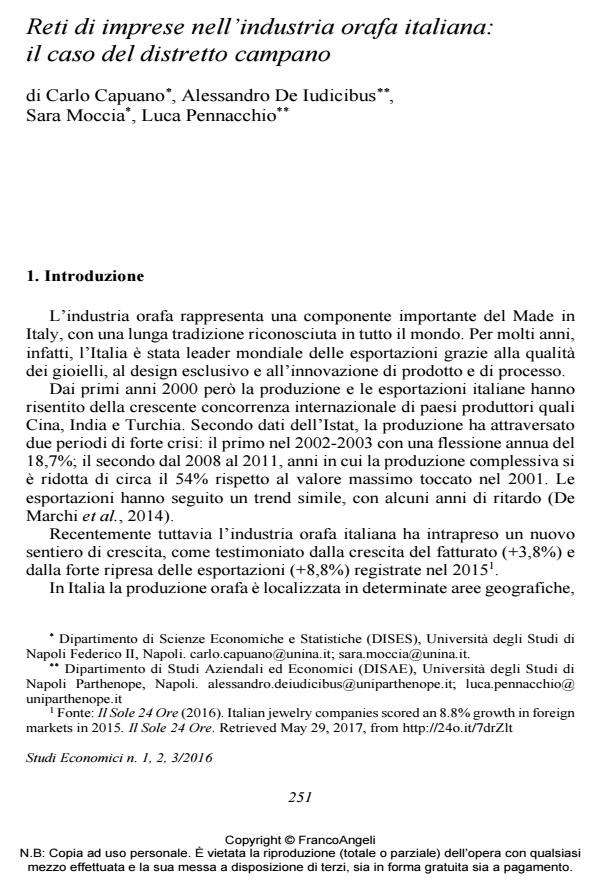Reti di imprese nell’industria orafa italiana: il caso del distretto campano
Titolo Rivista STUDI ECONOMICI
Autori/Curatori Carlo Capuano, Alessandro De Iudicibus, Sara Moccia, Luca Pennacchio
Anno di pubblicazione 2017 Fascicolo 2016/118-119-120 Lingua Italiano
Numero pagine 20 P. 251-270 Dimensione file 237 KB
DOI 10.3280/STE2016-118015
Il DOI è il codice a barre della proprietà intellettuale: per saperne di più
clicca qui
Qui sotto puoi vedere in anteprima la prima pagina di questo articolo.
Se questo articolo ti interessa, lo puoi acquistare (e scaricare in formato pdf) seguendo le facili indicazioni per acquistare il download credit. Acquista Download Credits per scaricare questo Articolo in formato PDF

FrancoAngeli è membro della Publishers International Linking Association, Inc (PILA)associazione indipendente e non profit per facilitare (attraverso i servizi tecnologici implementati da CrossRef.org) l’accesso degli studiosi ai contenuti digitali nelle pubblicazioni professionali e scientifiche
;
Keywords:Jewelry, industrial districts, clusters of firms, regional economy
Jel codes:L14, L23, L25, L52, O20
- Ardovino O., Pennacchio L. (2012), “Le determinanti della cooperazione nei distretti tecnologici italiani finanziati dal governo”, Studi Economici, 3, 121-149.
- Becattini G., Dei Ottati G. (2006), “The performance of Italian industrial districts and large enterprise areas in the 1990s”, European Planning Studies, 14(8), 1139-1162.
- Caliendo M., Kopeinig S. (2008), “Some practical guidance for the implementation of propensity score matching”, Journal of Economic Surveys, 22(1), 31-72.
- Capello R. (2004), Economia regionale, il Mulino, Bologna.
- De Marchi V., Lee J., Gereffi G. (2014), “Globalization, recession and the internationalization of industrial districts: experiences from the Italian gold jewellery industry”, European Planning Studies, 22(4), 866-884.
- De Propris L., Lazzeretti L. (2009), “Measuring the decline of a Marshallian industrial district: the Birmingham jewellery quarter”, Regional Studies, 43(9), 1135-1154.
- Del Monte A., De Iudicibus A., Moccia S., Pennacchio L. (2015), “La collaborazione nel settore dell’artigianato artistico in Campania: il caso dell’oreficeria”, Studi Economici, 3, 77-102.
- Fontefrancesco M.F. (2015), “Invisible Presences and Visible Absences: Jewellery industry and its crisis in Valenza, Italy”, Journal of Cultural Economy, 8(5), 597-612.
- Gertler P.J., Martínez S., Premand P., Rawlings L.B., Vermeersch C.M. (2011), “Impact Evaluation in Practice; La Evaluación de Impacto en la Práctica”, World Bank Publications.
- Greene W.H. (2011), Econometric analysis. 7th edn, Prentice Hall, New York.
- Heckman J.J., LaLonde R.J., Smith J.A. (1999), “The economics and econometrics of active labor market programs”, Handbook of Labor Economics, 3, 1865-2097.
- Il Sole 24 Ore (2016), “Italian jewelry companies scored an 8.8% growth in foreign markets in 2015”, Il Sole 24 Ore.-- http://24o.it/7drZlt
- Imbens G.W. (2004), “Nonparametric estimation of average treatment effects under exogeneity: A review”, Review of Economics and Statistics, 86(1), 4-29.
- Khandker S.R., Koolwal G.B., Samad H.A. (2009), “Handbook on impact evaluation: quantitative methods and practices”, World Bank Publications.
- Lazzeretti L. (2006), “Density dependent dynamics in the Arezzo jewellery district (1947-2001): Focus on foundings”, European Planning Studies, 14(4), 431-458.
- Long J.S., Freese J. (2006), “Regression models for categorical dependent variables using Stata”, Stata Press.
- Maddal G.S. (1986), Limited-dependent and qualitative variables in econometrics, Cambridge University Press.
- Ramazzotti P. (2010), “Industrial districts, social cohesion and economic decline in Italy”, Cambridge Journal of Economics, 34(6), 955-974.
- Regione Campania, Il Distretto Orafo Campano – Azione di sistema per l’accompagnamento ed il sostegno delle imprese dei distretti produttivi campa-ni nel processo di sviluppo di “reti di imprese”. -- http://www.regione.campania.it/assets/documents/orafo.pdf
- Rosenbaum P.R., Rubin D.B. (1983), “The central role of the propensity score in observational studies for causal effects”, Biometrika, 70, 1, 41-55.
- Rubin D.B. (1974), “Estimating causal effects of treatments in randomized and nonrandomized studies”, Journal of Educational Psychology, 66(5), 688.
Carlo Capuano, Alessandro De Iudicibus, Sara Moccia, Luca Pennacchio, Reti di imprese nell’industria orafa italiana: il caso del distretto campano in "STUDI ECONOMICI " 118-119-120/2016, pp 251-270, DOI: 10.3280/STE2016-118015